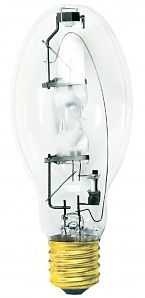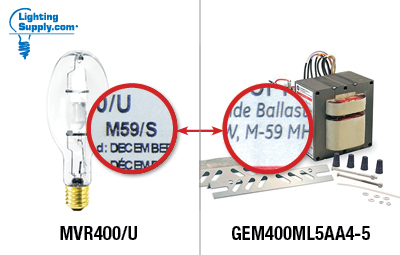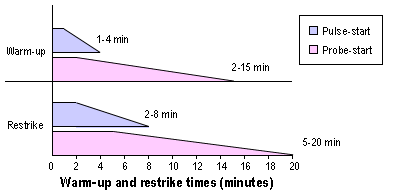|
Metal halide lights are one of the tried-and-true solutions to outdoor and high bay lighting because of their efficacy (ability to create many lumens, or a lot of light, per watt) and their quality of light. Part of the family of High Intensity Discharge (HID) lamps, metal halide lamps are the best in this family in terms of rendering colors correctly (as measured in CRI). While low pressure sodium lamps have a negative score on a traditional CRI scale of 0-100, and mercury vapor and high pressure sodium lamps typically score under 50 on this scale (well below 50 if they're not coated), metal halides score in the 60s and above (even into the 90s). Though they don't generally produce as many lumens per watt as high and low pressure sodium bulbs, metal halides still have a high efficacy rating ... approximately equal to LED lamps (although this is a little misleading, as we'll explain below). So sodium lamps may be chosen to light up areas where light is needed for safety but not visual acuity (like along a park trail or at a construction site where no work is happening at night). Metal halide lamps are preferred when both the quality and quantity of light are important. Common uses include parking lots, streets, warehouses, and athletic fields. 400 Watt Metal Halide Bulbs and Ballasts One of the most popular options among metal halides is the 400 watt metal halide bulb (or lamp). Producing over 30,000 initial lumens (and over 40,000 in the case of newer pulse start metal halides), these are used indoors on ceilings over 15 feet high to help brighten warehouses or other high bay settings, as well as in parking lot and street lights. Like any gas discharge lamp, metal halides require a lighting ballast to run, and they need to be matched according to their lamp type and wattage. For instance, you might have a 400 watt probe start metal halide lamp, and you would need a metal halide ballast specifically designed to run that. In the case of metal halide lamps, you can look at the ANSI code on the lamp and ballast and match these to verify compatibility. 400 watt probe start metal halide lamps and ballasts typically have an M59 ANSI code; and you typically have an M135 ANSI code on 400 watt pulse start metal halide lamps and ballasts. (Probe start lamps use an older technology with a starting probe inside the lamp. These are not as efficient, they lose more efficacy over the course of their lives, and they may not be rated to last as long as pulse start lamps.)
|
This blog's content is copyright © 2014-19 Lighting Supply.


